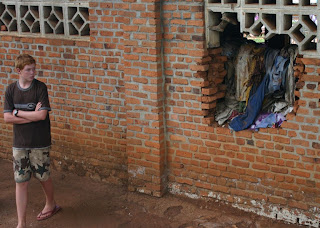Well, we’ve seen it. Yesterday afternoon we visited Ntarama church, the site of one of the bigger atrocities during the Rwandan genocide (5,000 people killed in one day). After that we went to the Genocide Museum in Kigali. Between the two, we can truthfully say that we’ve had our fill of sobering genocide memoria.
It’s not for the faint-hearted, and we weren’t sure how the kids would handle it. But they’ve seen so much already on this trip that we felt they’d probably take it in their stride. And, for anyone living in Africa, the events of 1994 in Rwanda are an important lesson in what can happen when it all goes wrong. So we agreed to go together and, with hindsight, it was a good decision.
The Ntarama church is stark. The church stands as it did when it was attacked. The grenade holes in the wall haven’t been patched up, and the scorch marks on the floors are still clearly visible. At the back of the church, rows of shelving hold hundreds and hundreds of human skulls, salvaged from the church when, eventually, it was cleaned up. Many of the skulls bear the marks of the machetes that killed their owners. Along the sides of the church hang the clothes of those whose families never came to reclaim them (most likely because they didn’t survive to do so). At the front, on top of the original altar, several large coffins hold the bones of the dead. Beside them are piles of shoes, belts and handbags, and beyond that a heap of plastic plates and mugs, water containers and tin cans. For three days before the attack, the 5,000 people had sheltered in the church in unimaginable conditions. Only ten escaped the slaughter, two of whom we met as guides around the church.
It’s not a conventional tourist experience. But it wasn’t a conventional political happening either. The least we can do is ensure that we and our children learn from it.
I think they did. They were subdued, of course (although Little Max’s ability to make irreverent remarks at inappropriate moments remained undiminished!). The display of children in the Genocide Museum had a particular impact. They showed life-size photos of some 20 kids, with a brief description of what their favourite foods were, which football teams they supported and what they wanted to be when they grew up. And then, at the bottom, was a one-line description of how they died. You couldn’t fail to be moved and the boys really empathised with this.
I’m glad we took them. They’ve seen so much of Africa’s beauty, and they have such a gloriously untainted perception of the continent and it’s people (you should see the uninhibited way in which they smile and wave at passers-by). An occasional glimpse into Africa’s darker side can’t be a bad thing. Whether they choose to live in Africa or not once they’ve grown-up, it will always be a part of them. And they’ll need to have a balanced perspective if they’re ever to do their part in trying to make it a better place. Hopefully, impressions like this will help.



No comments:
Post a Comment